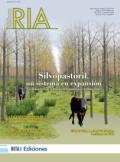Ver ítem
- xmlui.general.dspace_homeCentros Regionales y EEAsCentro Regional Mendoza - San JuanEEA San JuanArtículos científicosxmlui.ArtifactBrowser.ItemViewer.trail
- Inicio
- Centros Regionales y EEAs
- Centro Regional Mendoza - San Juan
- EEA San Juan
- Artículos científicos
- Ver ítem
Efecto de la restricción hídrica invernal en olivo (Olea europaea L.): el potencial hídrico xilemático y la conductancia estomática
Resumen
Durante la aplicación de una restricción hídrica invernal, en las temporadas de 2011 y de 2012, se cuantificaron y relacionaron el estado hídrico del olivo (Olea europaea L.) con el contenido de humedad del suelo y la temperatura ambiental. El experimento se realizó en olivos del cv. Arbequina de 10 años de edad implantadas en la EEA San Juan INTA (San Juan, Argentina). Los tratamientos aplicados fueron: T1, riego completo con reposición del 100% de la
[ver mas...]
Durante la aplicación de una restricción hídrica invernal, en las temporadas de 2011 y de 2012, se cuantificaron y relacionaron el estado hídrico del olivo (Olea europaea L.) con el contenido de humedad del suelo y la temperatura ambiental. El experimento se realizó en olivos del cv. Arbequina de 10 años de edad implantadas en la EEA San Juan INTA (San Juan, Argentina). Los tratamientos aplicados fueron: T1, riego completo con reposición del 100% de la evapotranspiración de cultivo (ETc) durante todo el ciclo y dos tratamientos con restricción hídrica (21 de junio al 31 de agosto), T2, regado con el 50% ETc y T3, sin riego, para el resto de la temporada los riegos fueron con el 100% de ETc. Se midieron el potencial hídrico xilemático (Ψtallo), la conductancia estomática (gs), el contenido de agua extraíble relativa (AER) del suelo y el efecto de la temperatura ambiental.
Los resultados demostraron la factibilidad en la aplicación de restricciones hídricas invernales en la región árida de Argentina con baja disponibilidad de agua durante ese periodo. Las disminuciones en el Ψtallo y en la gs dependen del contenido de AER del suelo y de la temperatura ambiental. La aplicación de una restricción hídrica que repone el 50% de la ETc, con una reserva inicial de agua fácilmente aprovechable (AFA) de 40 mm, afecta levemente el estado hídrico del olivo mientras que la aplicación de una restricción total del riego durante el invierno, sin reserva inicial de AFA, afecta severamente el Ψtallo y la gs hasta valores extremos -6,80 MPa y 5,67 mmol/m²/s, respectivamente. Los indicadores fisiológicos de Ψtallo y de gs del olivo se deben evaluar conjuntamente con el contenido de humedad del suelo
[Cerrar]
During the application of a winter water restriction in the seasons of 2011 and 2012, was quantified and related the water status of olive (Olea europaea L.) with soil moisture content and ambient temperature. The experiment was conducted in olive trees cv. Arbequina 10 years old in EEA San Juan INTA (San Juan, Argentina). The treatments were: T1, full irrigation with replacement of 100% of crop evapotranspiration (ETc) throughout
the cycle and two
[ver mas...]
During the application of a winter water restriction in the seasons of 2011 and 2012, was quantified and related the water status of olive (Olea europaea L.) with soil moisture content and ambient temperature. The experiment was conducted in olive trees cv. Arbequina 10 years old in EEA San Juan INTA (San Juan, Argentina). The treatments were: T1, full irrigation with replacement of 100% of crop evapotranspiration (ETc) throughout
the cycle and two treatments with water restriction (21 June to 31 August), T2, irrigated with 50% ETc and T3, no-irrigation, for the rest of the season with irrigation were 100% ETc. The stem water potential (Ψtallo), stomatal conductance (gs), relative extractable water (REW) soil and the effect of ambient temperature were measured.
The results demonstrated the feasibility in implementing winter water restrictions in the arid region of Argentina, with low water availability during that period. The decrease in Ψtallo and gs depends on the content REW of soil and ambient temperatures. Applying a water restriction which replaces the 50% ETc, with an initial reserve of easily available water (AFA) of 40 mm, slightly affects the water status of the olive tree; while implementing a full irrigation restriction during the winter, without initial reserve of AFA, everely affects the Ψtallo and gs to
-6.80 MPa and 5.67 mmol/m²/s, respectively. Irrigation scheduling during the winter using Ψtallo and gs must be evaluated together with the soil moisture content.
[Cerrar]

Fuente
RIA, 42 (2) : 186-200
Fecha
2016-08
Editorial
Gerencia de Comunicación e Imagen Institucional, DNA SICC, INTA
Formato
pdf
Tipo de documento
article
Palabras Claves
Derechos de acceso
Abierto
 Excepto donde se diga explicitamente, este item se publica bajo la siguiente descripción: Creative Commons Attribution-NonCommercial-ShareAlike 2.5 Unported (CC BY-NC-SA 2.5)
Excepto donde se diga explicitamente, este item se publica bajo la siguiente descripción: Creative Commons Attribution-NonCommercial-ShareAlike 2.5 Unported (CC BY-NC-SA 2.5)


